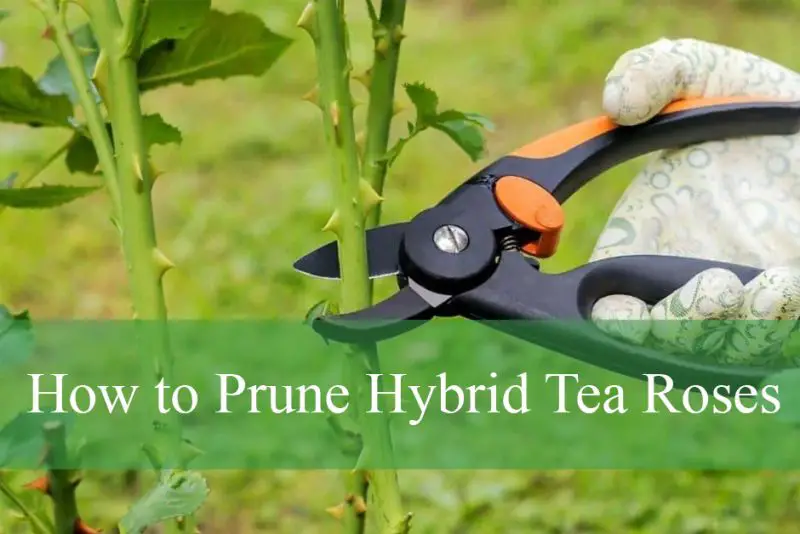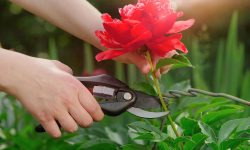Hybrid tea roses are celebrated for their long-stemmed, high-centered blooms and refined appearance, making them favorites in both gardens and floral arrangements. To enjoy vigorous plants and continuous flowering throughout the season, proper pruning is essential.
This guide provides a complete understanding of why, when, and how to prune hybrid tea roses, ensuring healthy growth and abundant blooms.
The Importance of Pruning Hybrid Tea Roses

Pruning is not merely a cosmetic task—it plays a crucial role in the long-term health and flowering potential of your rose bushes. When you remove old or unproductive wood, you stimulate the growth of new, flower-producing shoots. This results in a bushier plant with more blossoms and a tidier appearance.
Good pruning practices also improve air circulation within the plant’s canopy, reducing the risk of fungal diseases such as black spot and powdery mildew. In addition, by cutting away dead, damaged, or diseased stems, you eliminate hiding places for pests and prevent infections from spreading.
Pruning helps maintain a manageable size and an attractive shape. For older or declining plants, rejuvenation pruning can reinvigorate growth and restore bloom performance. Removing weaker stems allows the plant to channel energy into stronger shoots, capable of supporting the hybrid tea rose’s large, heavy flowers.
When to Prune Hybrid Tea Roses
Timing is everything when it comes to pruning roses. Pruning at the appropriate time can maximize flowering and reduce stress on the plant.
Dormant Pruning in Late Winter or Early Spring
The main pruning session should be done while the plant is dormant, usually between late February and early April. In warmer climates, pruning may begin earlier, while colder regions require gardeners to wait until the danger of frost has passed. The best indicator is the swelling of leaf buds, which signals that the plant is preparing to break dormancy.
Choosing the right moment ensures that the plant recovers quickly and produces strong new growth. Pruning too early in cold zones can lead to frost damage on tender shoots, so timing should always align with your local climate conditions.
Summer Pruning During the Blooming Season
During the growing season, summer pruning mostly involves deadheading. This process of removing faded flowers helps the plant redirect its energy from seed production into forming new blooms. Deadheading should be done promptly as flowers begin to fade, cutting back to a leaf with five leaflets, just above an outward-facing bud.
This encourages additional flowering cycles and helps keep the plant tidy and vigorous throughout the blooming season. Done correctly, summer pruning can extend the blooming period significantly.
Light Pruning Throughout the Growing Season
Occasional light pruning throughout the growing season helps maintain the shape and overall health of your rose bush. This includes removing crossing branches that may rub and cause wounds, as well as trimming away thin, weak stems that are unlikely to support quality blooms.
If any branches grow too long or in an awkward direction, cutting them back will help keep the plant’s structure balanced. These minor adjustments can prevent problems and support steady growth.
Fall Pruning in Colder Climates
In autumn, minimal pruning is recommended, especially in regions with harsh winters. Cutting back excessively can lead to new growth that may be damaged by frost. However, lightly shortening long canes helps protect the plant from wind damage.
Removing diseased leaves or visibly infected stems in fall can also reduce the likelihood of pathogens surviving through winter. Still, avoid heavy pruning at this time to prevent stressing the plant before dormancy.
Essential Tools for Pruning Hybrid Tea Roses
Using the right tools ensures clean cuts and prevents damage to your rose bush. Bypass pruners are ideal for stems up to three-quarters of an inch thick and offer clean, scissor-like cuts that heal quickly. For thicker stems, loppers provide extra leverage and cutting power, while a small pruning saw may be necessary for particularly large or woody canes.
Wearing thick, puncture-resistant gloves is highly recommended, especially when working with thorny canes. Gauntlet-style gloves that protect the forearms offer the best protection. Keeping tools disinfected with rubbing alcohol between cuts, particularly when removing diseased material, is crucial to preventing the spread of pathogens.
Core Principles of Hybrid Tea Rose Pruning
Before making any cuts, keep in mind several key pruning principles that apply to all hybrid tea roses. Always use sharp, clean tools to avoid tearing the stems, which can invite disease. Cuts should be made at a 45-degree angle, sloping away from the bud, to allow water to run off easily.
Aim to cut just above an outward-facing bud to promote open, outward growth. This results in a vase-shaped plant with good air circulation. Cutting above an inward-facing bud can lead to a congested center, which increases disease risk. Always prioritize the removal of dead, diseased, and damaged wood—the “three Ds.”
Avoid leaving stubs, as they can die back and become entry points for pests or disease. Lastly, remove any suckers that appear below the graft union. These vigorous shoots belong to the rootstock and will not produce desirable blooms. They should be removed completely at the base.
Step-by-Step Guide to Dormant Pruning
Dormant pruning is the most important pruning session of the year. It sets the stage for a season of vigorous growth and abundant blooms.
Preparing for Dormant Pruning
Begin by gathering your tools—bypass pruners, loppers, and a pruning saw if necessary. Clean all blades with disinfectant before starting, and wear protective clothing and gloves to guard against thorns.
Take time to assess the rose bush carefully. Identify dead, damaged, and diseased wood. Dead wood is typically dry and discolored. When you cut into it, you may see a brown center. Continue cutting until you reach healthy white or green tissue. Diseased wood may have visible cankers or galls and should be removed completely, several inches below the visible damage.
Removing Weak and Problematic Growth
Thin, spindly canes—those thinner than a pencil—should be removed at the base, as they rarely produce quality flowers. Also remove any canes that cross or rub against each other, selecting the healthier or better-positioned branch and discarding the other. This opens the center of the bush and encourages airflow.
Shaping and Reducing the Height
Now shape the bush and decide on its final height. Most hybrid tea roses are pruned to stand between 18 and 30 inches tall. Shorter pruning can result in larger blooms, while taller pruning often produces more flowers overall.
Choose three to five strong, healthy canes to form the main structure of the bush. These should be at least pencil-thick and originate from the base. Cut them back to an outward-facing bud using a clean, angled cut. Remove any growth directed toward the center to maintain an open, vase-like shape.
Final Steps and Cleanup
After pruning is complete, collect and discard all clippings and leaves, especially those showing signs of disease. This prevents pests and fungal spores from overwintering in the debris.
Thoroughly disinfect all tools before storage. As an optional final step, consider applying a dormant oil spray to smother insect eggs or fungal spores. Follow product instructions carefully to ensure effective and safe use.
Advanced Pruning Techniques and Considerations
Pruning for Exhibition Blooms
When cultivating roses for exhibition-quality blooms, more aggressive pruning is often required. Reducing the number of primary canes to just three or four allows the plant to concentrate its resources on fewer stems, leading to larger flowers. These canes should be cut back significantly—ideally to a height of 10 to 15 inches—to encourage robust new growth.
During the growing season, disbudding becomes essential for show blooms. Once flower buds begin to develop, remove all but the largest and healthiest central bud on each stem. This technique channels the plant’s energy into producing one impressive flower per stem, enhancing bloom size and form.
Rejuvenation Pruning for Older Roses
Neglected, aging, or unproductive hybrid tea roses may benefit from a rejuvenation pruning approach. This method involves cutting all canes back to a height of 6 to 12 inches above the ground. Such a severe cut encourages fresh, vigorous shoots to emerge from the plant’s base, helping to reinvigorate its overall health.
Rejuvenation pruning should only be performed during the plant’s dormant season to reduce stress and allow for proper healing. While the rose may take a full season or more to recover, this technique can ultimately restore flowering and vigor to an otherwise declining specimen.
Dealing with Rootstock Suckers
Rootstock suckers can be problematic for grafted roses, as they divert energy away from the desired variety. These unwanted shoots often emerge from below the graft union and can usually be identified by their different foliage—such as more numerous leaflets, a change in color, or a coarser texture.
To effectively remove suckers, it’s important not to simply clip them at ground level. Instead, expose the base of the shoot by carefully digging away the surrounding soil, then remove the sucker flush with the rootstock. This helps prevent it from regrowing more aggressively.
Pruning for Repeat Bloom (Deadheading in Detail)
Deadheading plays a critical role in promoting continuous flowering throughout the growing season. When a bloom fades, follow the stem down to the first set of five leaflets—ignoring any sets of three. Make a clean cut just above this five-leaflet junction at a 45-degree angle, making sure to cut above an outward-facing bud to encourage strong, directional new growth.
In late summer or early fall, gardeners may choose to stop deadheading if they want the rose to develop hips, or seed pods. These hips can provide seasonal interest in the fall and winter, adding ornamental value beyond the flowering season.
Common Pruning Mistakes to Avoid
Pruning Too Early in Spring
One of the most frequent mistakes gardeners make is cutting back roses too early in the spring. Early pruning can trigger new growth while the risk of late frost still lingers. This tender growth is highly susceptible to cold damage. It’s best to wait until the buds on the canes begin to swell and the danger of severe frost has passed.
Pruning Too Late in Fall
Another common error is heavy pruning in the late fall. This practice often stimulates soft, new growth that does not have enough time to harden before winter. As a result, the plant becomes more vulnerable to frost damage, which can set back its health and performance the following year.
Using Dull or Dirty Tools
Poorly maintained tools can cause more harm than good. Dull blades make ragged cuts that take longer to heal and increase the risk of disease. Similarly, dirty tools can transfer pathogens between plants. Always ensure your pruning shears are both sharp and clean before beginning any work.
Leaving Stubs
Leaving stubs after pruning is a mistake that can compromise the plant’s health. Stubs do not heal properly and often become entry points for pests and rot. Each cut should be made cleanly, just above a healthy bud or at the base of a cane, to allow for proper healing and strong new growth.
Cutting to Inward-Facing Buds
Directing new growth toward the center of the plant creates a crowded interior. This dense structure restricts airflow, which can lead to higher humidity and an increased risk of fungal diseases. Always cut above an outward-facing bud to maintain an open, airy shape.
Not Removing Suckers
Failing to remove suckers can drastically reduce a rose’s performance. These shoots arise from the rootstock and drain energy away from the grafted variety, leading to fewer and smaller blooms. Prompt and thorough removal helps ensure the rose maintains its desired vigor and form.
Not Disinfecting Tools Between Cuts
Especially when dealing with diseased branches, it’s essential to disinfect pruning tools regularly. Without proper sanitation, diseases can spread rapidly from one cut to another, infecting otherwise healthy parts of the plant. Using a disinfectant such as rubbing alcohol or a bleach solution between cuts minimizes this risk significantly.
Post-Pruning Care
Fertilize to Support New Growth
After pruning is complete and new shoots begin to emerge, it’s important to provide your hybrid tea roses with the nutrients they need to grow vigorously. Apply a balanced rose fertilizer at this stage to support healthy foliage and promote the development of abundant blooms. This nourishment is especially crucial in helping the plant recover from the stress of pruning.
Water Thoroughly and Consistently
Proper hydration is essential for recovery and strong growth following pruning. Make sure the plant receives deep, consistent watering, particularly during dry or warm periods. Moisture at the root level encourages healthy development and helps the rose maintain resilience against environmental stress.
Apply Mulch for Protection and Moisture Retention
Adding a layer of organic mulch around the base of the rose can significantly improve its growing conditions. Keep the mulch a few inches away from the crown to prevent rot, and cover the surrounding soil to conserve moisture, regulate soil temperature, and suppress weed growth. This protective layer also contributes to overall plant health during the growing season.
Monitor for Pests and Diseases
Even with improved air circulation and plant vigor resulting from proper pruning, it’s important to remain vigilant. Check regularly for any signs of pests or disease. Early detection and prompt action can prevent minor issues from escalating and ensure your roses remain healthy and productive throughout the season.
Conclusion
Pruning hybrid tea roses may seem daunting at first, but by understanding the “why” and “when,” and practicing the “how,” you’ll quickly gain confidence. Regular, proper pruning is the key to maintaining healthy, vigorous rose bushes that produce an abundance of their iconic, beautiful blooms year after year. With sharp tools, a little patience, and attention to detail, you can transform your rose garden into a vibrant display of color and fragrance. So, don’t be afraid to make those cuts – your roses will thank you for it!






